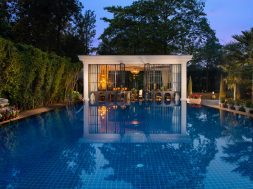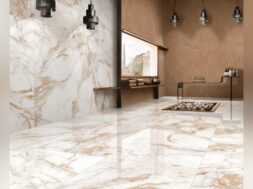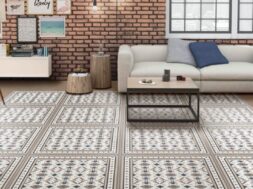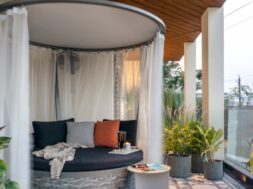Glassical Interiors

The infusion of glass as an element of architecture and interiors has allowed the creation of magnificent design narratives. From interior accessories to adding transparency in new age projects, the role of glass has grown exponentially.
Since ancient times, glass has been in constant use for interior design. After the industrial revolution and the increased accessibility of the material, the use of glass broke the stereotypical barriers of exclusive use in palaces and royal structures and slowly started being incorporated in common households as well. Today the role of glass extends from interior accessories like chandeliers, lamps, furniture pieces to sculptures, doors, windows and facades
Use of Glass in interiors
“With the improving technology, glass has also progressed to become one of the most widely used material in interior design today,” says Abhigyan Neogi, “majorly known for its transparency, glass can be utilised in a wide range of areas in interior design. It is commonly used to let light pass through a place and make it lighter and display the colors and the design and reduce the use of artificial energy. Glass also gives a serene feel and creates a physical division of space devoid of a visual obstruction. Back painted glass can convert almost any room, from kitchens to bathrooms, showers, wall covering and table tops into a beautiful and splendid space.”
“Being a fantastic element to create a mirage in spaces, glass helps a space to respond with its mutation of utility,” says Kapil Mehta, Principal Architect, Kapil Mehta & Associates. “This could be best explained through my own office design where, with its two glazed peripheries, the workspace forms an ocular connection with the visitors. While maintaining perfect privacy, serving an official regime with one face and giving the aura of a lush garden through second, the technique makes for a holistic barrier-free interior grammar. It exemplifies the physical separation of the zones while connecting them visually.”
Use of Glass in Workspace Design
“The use of glass has certainly allowed for adoption of a seamless workspace and a more open format of working,” says Abhigyan Neogi, Founder Principal of Chromed Design Studio “With the transparency that is facilitated by glass, the interaction is much more effective and precise among colleagues which in turn enhances the productivity and collaboration among them. For the same reason, the stringent hierarchical divisions of spaces meant for senior level employees is felt less and this gives their subordinates much more confidence and make them approachable.”
“Glass grants an ethical and commodious appeal to an expanse without any impediment and at the same time it can become a large canvas to express an artistic value add,” points out Kapil Mehta “more and more corporate entities are adopting an open office format as It gives off a contemporary yet serene feel. The idea behind open-plan offices is to tear down the physical and metaphorical walls that divide workspace into cubicles and employees establish a positive connect between colleagues and co-professionals. The intention is to increase communication and foster an environment of collaboration in the office. I comply with the format and stand by its diverse uses in terms of utility and design and aesthetics.”
Use of Glass in Furniture
The use of glass in furniture design has been profound in recent times. Null, the latest collection by Studio Buzao which debuted during Design Shanghai earlier this year acts as a good example. The suite of furniture, which includes a table lamp, bench, shelf, and tables, embraces a singular geometric language of stacked rectangular volumes and spheres. Their sleek outlines and sharp corners recall the forthright minimalism of modernist design, while their sculptural compositions blur the distinctions between design and art.
Null’s laminated glass surfaces have been treated with gradients of opacity that shift from a deep blue to a translucent blue, then ultimately to a totally transparent shade. The resulting reflections and refractions cast by the glass pay poetic homage to the spirit of light and space, an artistic movement of 1960s Southern California that was heavily influenced by environmental phenomena. Visually, the partial transparency of the design renders portions of it nearly invisible, conceptually render it as immaterial as the sky itself.
The collection employs a sustainable method of lamination that is both environmentally friendly and fade resistant. Custom colors and sizes are available in an unlimited array of options.
With the transparency that is facilitated by glass, the interaction is much more effective and precise among colleagues which in turn enhances the productivity and collaboration among them.
Abhigyan Neogi, Founder Principal of
Chromed Design Studio
Glass grants an ethical and commodious appeal to an expanse without any impediment and at the same time it can become a large canvas to express an artistic value add.
Kapil Mehta, Principal Architect,
Kapil Mehta & Associates.
7
Cookie Consent
We use cookies to personalize your experience. By continuing to visit this website you agree to our Terms & Conditions, Privacy Policy and Cookie Policy.









